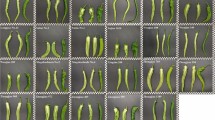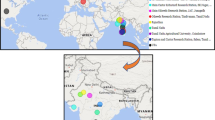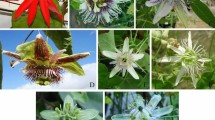Abstract
A set of 208 Indian and two Thai germplasm accessions of opium poppy Papaver somniferum were assessed for variation in 17 morphological characters, seed yield and content and yield of morphine from capsules and peduncles. The germplasm was found to be highly variable for all the characters evaluated. In the harvested peduncles and capsules, 13% was peduncle straw, 61% seeds and the rest capsule husk. The peduncle and capsule straw yields ranged between 0.6–2.2 and 1.4–5.3 g plant-1, respectively. Morphine content in the peduncle varied between about 0.001–0.24% and that in the capsule from 0.02 to 1.05%. On average basis morphine content in the capsule husk was more than 9-fold higher than the peduncle straw. The plant morphine yields from peduncles and capsules ranged between 1.2 and 28.6 mg plant-1. Four accessions yielded more than 20 mg of morphine plant-1. Among these, in one of the accessions about 13% of the morphine was contributed by the peduncle. The plants of high morphine yielding accessions were generally small in height, and bore white flowers and large sized ungrooved capsules with a small number of seeds, on a large peduncle.
Similar content being viewed by others
References
Anonymous, 1966. In: Raw Material. Wealth of India. VII, pp. 231–246. Council of Scientific Industrial Research, New Delhi, India.
Bajpai, S., M.M. Gupta & S. Kumar, 1996. A low morphine containing accession of Papaver somniferum suitable for seed production. Plant Breed. 15: 425–426.
Bernath, J. & P. Tetenyi, 1982. Production characteristics of Papaver somniferum L. cultivars of different origin and vegetation cycles. Bull. Narcotics 34: 113–127.
Cochran, W.G. & G. Cox, 1957. In: Experimental Designs, 2nd ed., pp. 1–629. John Wiley and Sons, New York, NY.
Facehini, P.J. & D.A. Bird, 1998. Developmental regulation of benzylisoquinoline alkaloid biosynthesis in opium poppy plants and tissue cultures. In vitro cell. Dev. Biol. Plant 34: 69–79.
Gupta, M.M. & R.K. Verma, 1996. Combined thin layer chromatography-densitometry method for the quantitative estimation of major alkaloids in poppy straw samples. Indian J. Pharm. Sci. 58: 161–162.
Hofman, P.J. & R.C. Menary, 1979. Variations in morphine, codeine and thebaine in the capsules of Papaver somniferum L. during maturation. Aust. J. Agric. Res. 31: 313–326.
Kapoor, L.D., 1995. In: Opium Poppy: Botany, Chemistry and Pharmacology, pp. 1–348. Food Products Press, New York, NY.
Liersch, J. & J. Krzymanski, 1993. New forms of low morphine poppy. Postepy. Nauk. Rolniczych. 40/45: 99–100.
Nessler, C.L. & P.G. Mahlberg, 1979a. Plastids in laticifers of Papaver. I. Development and cytochemistry of laticifers plastids in P. somniferum L. (Papaveraceae). Am. J. Bot. 66: 266–273.
Nessler, C.L. & P.G. Mahlberg, 1979b. Plastids in laticifers of Papaver. II. Enzyme cytochemistry of membrane-bound inclusions of laticifer plastids in P. bracteatum Lindl. (Papaveraceac). Am. J. Bot. 66: 274–279.
Nessler, C.L & P.G. Mahlberg, 1981. Cytochemical localization of cellulase activity in articulated, anastomosing laticifers of Papaver somniferum L. (Papaveraceae). Am. J. Bot. 68: 730–732.
Sharma, J.R., H.O. Mishra, R.V. Nair, R.K. Srivastava, O.P. Singh & D.P. Srivastava, 1981. Phenological distribution of latex yield and plant type concept in opium poppy (Papaver somniferum L.). Indian Drugs 19: 64–69.
Singh, S.P., S. Shukla & K.R. Khanna, 1995. Opium poppy. In: Chadha, K.L. & R. Gupta (Eds), Advances in Horticulture-Medicinal and Aromatic Plants, 11, pp. 535–574. Malhotra Publishing House, New Delhi, India.
Tetenyi, P., 1997. Opium Poppy (Papaver somniferum); Botany and Horticulture. In: Janick, J. (Ed.), Horticultural Reviews, 19, pp. 373–408. John Wiley & Sons, UK.
Wagner, H., S. Bladt & E.M. Zgainski, 1984. In: Plant Drug Analysis. A Thin Layer Chromatography Atlas, p. 780. Springer-Verlag, Berlin.
Author information
Authors and Affiliations
Rights and permissions
About this article
Cite this article
Bajpai, S., Gupta, A.P., Gupta, M. et al. Inter-relation between descriptors and morphine yield in Asian germplasm of opium poppy Papaver somniferum. Genetic Resources and Crop Evolution 47, 315–322 (2000). https://doi.org/10.1023/A:1008752805362
Issue Date:
DOI: https://doi.org/10.1023/A:1008752805362




